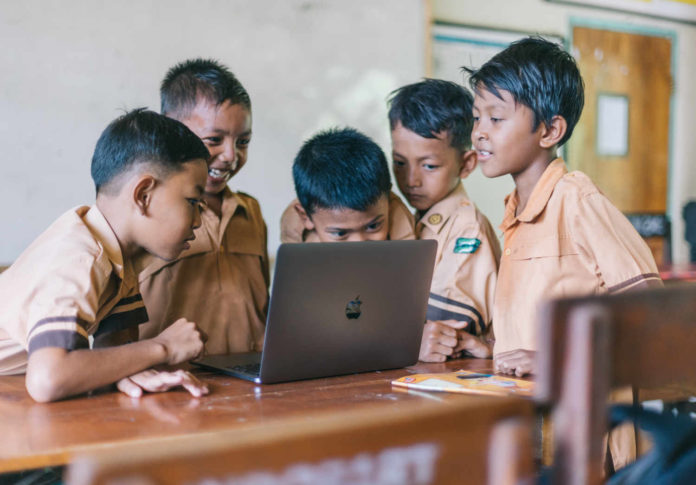Game-based learning presents both challenges and opportunities. Digital literacy, access to digital devices, and connectivity — particularly in some parts of Asia — can introduce barriers to learning through games.
Traditional views on education may question the learning outcomes of educational games, unaware of the benefits of online games for students.
Three passionate educators from three continents — Asia, Africa, and North America — spoke about the advantages of games in education at LEARNTech Asia’s webinar The Pedagogy of Online & Offline Game-based Learning: Strategies & Applications.
Talitha Amalia of Solve Education!, Indonesia; Amanda Calitz of University of the Witwatersrand (WITS), South Africa; and Sonia Michaels of DigiPen Institute of Technology, USA, shared their thoughts on why games are important for students and gave some tips on how to create game-based learning.
How are games educational?
For parents and learners unfamiliar with the benefits of gamification in education there is the social stigma of learning being serious business.
“’If my kid is playing and having fun, that’s not learning,’” said Sonia, quoting the resistance from some parents. “’Learning should be hard, focused, and difficult.’”
“Some of the 21st-century skills taught through game-based learning are critical thinking, collaboration and skilled communication, self-regulation, and problem-based learning,” said Amanda.
Solve Education!, a non-profit organization committed to helping children and youth around the globe receive quality, effective education, designed a free game-based learning platform where teachers, educational institutions, and global content creators collaborate and contribute to the game content.

An effective approach to educational game design in learning is the same as any game design. The focus is on the user journey. Users select and download a game, which are assigned subjects. As they are onboarded to a simulation game, they are given a role.
“So if you don’t know how to create game designs, if you don’t know how to code, you can still gamify your content,” explained Talitha, who is Director of Program Operations.
“As long as you have your own materials, you can gamify them through our platform Content+, and then you can measure the activity of the learners through our analytics or learning management system that is integrated to this (app) Dawn of Civilization.”
Improve digital literacy
Amanda’s nursing education students in South Africa are in their 30s and 40s and many have never used a computer. Learning with augmented reality could be a big step.
“Some students when they reach university it would be the first time that they hold a laptop or a computer in their hands,” explained Amanda. “So they’re kind of scared. ‘What are my peers going to think? They’re going to notice that I don’t know how to use a mouse or a keypad?’”

The first step was to improve their digital literacy, and Minecraft was a good entry point to familiarize themselves with game-based learning.
“We spent about two to three months just learning Minecraft and mapping the digital literacy,” Amanda explained.
“Following that was transferring curriculum knowledge to the game platform, showing students examples of parts of the body and their functions in Minecraft, followed by the students actually building systems in the body in Minecraft.”
“Because we played Minecraft with groups of 60 students if no one in the group has played Minecraft before, it’s a good leveler of the playing field,” explained Amanda. “Everybody bonds and grows together.”
Motivation and engagement
“One of my favorite parts of education is to see the spark in someone’s eye when they see something for the first time,” said Amanda, who spoke of her health sciences students building human systems in Minecraft.
In creating game-based learning there is no one size fits for all. “Every age group has a different motivation level,” said Talitha.
“Learners below age 18 are more interested in role-playing or competitive simulations. Young adults have developed a stronger motivation for learning. They want to see progress. They want more social interaction with their friends, because of their social media platforms.”
Interactive games promote creative problem solving and critical thinking skills. “It gets the students one step closer to what they’re learning about, instead of observing it from a distance,” explained Sonia. “They feel much more involved.”
Game-based education encourages cooperative and pro-social behavior. It’s not just competitive. It is students helping each other learn and supporting each other and working together to get to the best outcomes.
“Games help students of all ages learn that you don’t have to be perfect the first time you do something,” said Sonia. “You can work at something and fail and try again. And that is how you develop true mastery of a skill.”
“It’s pretty easy to get students engaged with game-based learning, even if it’s really difficult stuff,” added Sonia. “Games really get students involved even in subjects that might otherwise be stress-inducing for them.”
Learning curve for teachers
“I understand that a lot of teachers are nervous about the learning curve for themselves as well as for students because some teachers are more technologically adept and some less so and some don’t really want to learn,” said Sonia.
Talitha explained the barriers to game based learning in Indonesia: “We deal with lots of teachers from low-income backgrounds that don’t necessarily have fancy hardware like laptops. They only have smartphones.”
So despite the development of a free LMS gamification template where teachers can simply enter their course material into a quiz application, it’s still not easy for everyone.
“Our platform is still complicated for them, and we still get resistance from teachers from adopting the technology that we built,” explained Talitha. “For teachers to be involved in the gamified environment it’s still a challenge.”
Solve Education! says the way to get buy-in from teachers is to demonstrate the effectiveness of the LMS.
“From our experience on the ground with a learning management system, the way to hook — to get teachers engaged — because ultimately they always ask, ‘Is it effective? How do we measure learning outcomes?’ Always outcomes. Why? Because they have pressure from the principal. The government likes to improve learning outcomes,” says Talitha.
How to make an educational game online
Teaching with narrative games is one strategy in creating microlearning modules in game-based learning. An open-source tool such as Twine is one tool to make an educational game online. Twine can be used for telling interactive, nonlinear stories.
“I taught myself to use Twine in about two hours. I don’t know any code at all. So if I could teach myself to use it in two hours, anyone can,” explained Sonia, who is a Senior Lecturer at DigiPen Institute of Technology, where she helps teach people how to make games.
Twine can use simple text only. Pictures and audio can be added. “It will take more time if you want to get more fancy with it,” Sonia said.

“But it is so fun to work with. Because once you know those basics, you have endless opportunities to work with this.”
“Folk tales and fairy tales are great ways to teach people of all ages about certain concepts and ideas in story and literature,” she added.
“And with these little narrative games, you can actually create little games in which the students can change the outcomes of the story.”
Assessment
When learning through games, motivators such as points, digital coins and badge system gamification are incentives within any game design. The player moves up to the next level while at the same time learning.
“But the challenge is to make sure that the materials and the content being delivered through games are effective,” cautioned Talitha.
“That also requires a shift of mindset from teachers because they are used to evaluating teaching materials conventionally, like an essay, for example. They are the ones giving feedback. They don’t allow the kids to give feedback to one another.”
“I enjoy gamifying a baseline assessment at the beginning of a lesson. Then you can use something like Quizizz or Kahoot to see where all the students are,” explained Amanda.
“It can also be an incentive. At the end of the week, especially when I was still teaching grades 4 to 6, we are going to play Kahoot on a Friday for an incentive if you behave throughout the week.”
Gamification during a pandemic
During the COVID-19 lockdowns worldwide, learning abruptly switched to video conferencing platforms such as Zoom, Google Meet, and Microsoft Teams.
When digital devices were hard to access, or internet connectivity became an added financial burden to learners from at-risk families, a learning gap loomed.
“The education technology industry has seen this as an opportunity,” said Talitha, in regards to the sudden shift to learning from home. “Therefore, they develop various different products to address this issue, but unfortunately, they don’t really capture our families who can’t afford it.”
“So the platforms or the products that they develop usually are quite expensive. The families have to subscribe. Or even if it’s free, it has to be online.”
The cost of internet data credits for learning online continues to be an issue, as acknowledged by Indonesia’s education minister Nadiem Makarim.
Amanda reported a similar situation with access to internet data in South Africa. “We have a big problem with data usage and Minecraft, unfortunately, takes a lot of data. Currently, we are recording videos of what students would experience playing Minecraft, and then we send them. The videos, like for the pharmacy project, we are going to send the video, and then they can answer the questions as if they played,” she said.
A familiar story of learner transformation was echoed when it came to game-based learning during the pandemic.
“Kids who are not particularly active in the classroom became more engaged in the learning process during the pandemic,” explained Talitha.
As students across Indonesia were learning from home, Solve Education! saw an increase in the use of their gamification platform.
“Because of the pandemic, the adoption (of the gamification platform) was somehow enhanced, (people) were forced to adopt the technology. Otherwise, the kids won’t learn. So because of that support from the communities as a whole, the adoption of gamification has been increasing in the past few months and the trends that we see is that kids who weren’t necessarily active in the classroom are now more engaged and became so-called ‘power users,’ which means they aggressively ask questions or complain when something doesn’t go well. They help their peers online because they’re more talkative on the chat feature.”
“I think right now, whether we’re teaching through games or not, the importance of compassion and patience can’t be overstated,” said Sonia.
“Everyone’s attention spans are off a little bit, their focus is off, including the teachers. I love the idea of giving them a little bit of extra time and flexibility because we want them to learn the material. We don’t need them to learn it by Wednesday at 3 o’clock. We just want them to learn it at this point. And so I absolutely agree with that.”
And the time apart that learners and teachers are feeling is certainly communicated.
“In lockdown, they haven’t seen each other for a while. And I do get messages often like, ‘Ma’am, When can we play Minecraft, or can we do it remotely?'” said Amanda, of her students in South Africa.
“So I think games are a very good unifier.”




